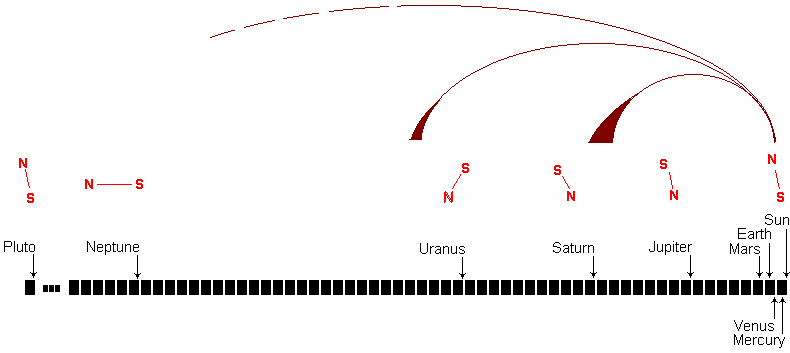
| |
 |
![]()
The Zetas have always asserted that the Sun dominated the solar system's magnetic field, and did not flip its poles every 11 years as NASA has asserted. The Zetas stated that the Sun's influence reached to the end of the solar system, and that a magnetic influence affecting the solar system came from beyond the solar system, triggering what the Zetas called the Magnetic Trimesters.
- Magnetic influences between planets are greater than humans imagine, because they use as their frame of reference objects on the surface. The Earth's crust is magnetically diffuse, representing many different pole alliances over the eons, as magma hardened after volcanic eruptions during pole shifts. The Earth's thick crust acts as a shield in this way, so that only sensitive needles on compasses, floating freely, jiggle into alignment with the Earth's core. A planet's magnetic influence is not encapsulated by its crust, but reaches beyond this even to the ends of the solar system.
- ZetaTalk: Planetary Magnetism, written February 15, 1996
- When this path of least resistance is established in a gaseous planet, the magnetic particle flow takes a short cut to the south pole of the Sun, the dominant magnetic influence in the area. Those particles flowing through such a gaseous magnet do not return to the south pole of the planet they have just passed through, but move along to the south pole of the Sun. Magnetic fields are measured by man not by the flow of particles, but by the direction of the flow, as the orientation is determined by which way a magnet swings under the influence of this flow. Thus, probes sent to measure the magnetic field of a gaseous planet find their test magnets swinging into alignment, both the south pole of the gaseous planet and the test magnet lined up to act as a conduit for the intense flow of magnetic particles on the move. The fact that there is no actual field about the gaseous planet, no return from the north pole of the gaseous magnet to its south pole, is not noted.
ZetaTalk: Opposition, written 2001

- Why is it the Sun, as the giant magnet dominating the solar system, points North and South with its poles in the directions it does? For those late to this argument, the Sun does not reverse polarity every 11 years as NASA states, and the solar magnetic field reaches beyond the outer bounds of the solar system, affecting all the planets. The Sun likewise is under the dictates of influences that surround it, and as the Sun goes, so go the planets.
- ZetaTalk: Magnetic Trimesters, written 2001
On October 15, 2009 NASA admitted that the prevailing concept of how the solar system was shaped was wrong. They had assumed it was delimited by the solar wind, creating a comet like shape - a nose cone in front and a tail in the back. Their own probe demonstrated that the solar system was in the shape of a bubble, delimited by magnetic particle flow.
- Cassini Data Help Redraw Shape of Solar System
October 15, 2009
http://www.jpl.nasa.gov/news/features.cfm?feature=2337- Images from the Ion and Neutral Camera on NASA's Cassini spacecraft suggest that the heliosphere, the region of the sun's influence, may not have the comet-like shape predicted by existing models. In a paper published Oct. 15 in Science Express, researchers from the Johns Hopkins Applied Physics Laboratory present a new view of the heliosphere, and the forces that shape it. As the solar wind flows from the sun, it carves out a bubble in the interstellar medium. Models of the boundary region between the heliosphere and interstellar medium have been based on the assumption that the relative flow of the interstellar medium and its collision with the solar wind dominate the interaction. This would create a foreshortened "nose" in the direction of the solar system's motion, and an elongated "tail" in the opposite direction. The Ion and Neutral Camera images suggest that the solar wind's interaction with the interstellar medium is instead more significantly controlled by particle pressure and magnetic field energy density.
- NASA's IBEX Spots Mystery Emissions at Edge of Solar System
October 15, 2009
http://www.foxnews.com/story/0,2933,567020,00.html- "[The ribbon is] aligned by and dominated by the external magnetic field," McComas said in a briefing Thursday. "That's a huge clue as to what's going on. But still we're missing some really fundamental aspect of the interaction - some fundamental physics is missing from our understanding." The new IBEX results will be published in the Oct. 16 issue of the journal Science.